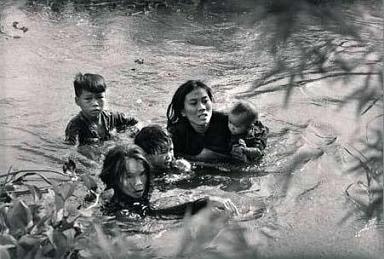The photo won the World Press Photo award in 1965.
Sawada bravely took the photo under the rain of bombs from American planes. As his subjects approached the shore, Sawada wiped away the tears of the youngest child.
Author: Kyoichi Sawada, Japan, reporter for UPI news agency.
|
Later, Sawada's wife confided: "Those photos were the most powerful evidence of the tragedies of war, they contributed to making my husband's name. But it was also because of that that it put him under so much pressure that he suffered from depression."
Born February 22, 1936, age 13 - first held a camera while working as a newspaper delivery man.
Loc Thuong - Binh Dinh - South Vietnam 1965. A mother and her children are trying to cross the river to avoid American bombs.
The price of war is not only the soldiers who die for it, but also the tragedy of civilians. Sawada is someone who understands this very well.
Someone once told him: Glory from war only comes to generals and photographers. In 1961, when the Vietnam War escalated more and more fiercely, Sawada was refused permission to go to Vietnam because he believed that this was an American war of aggression.
So in 1965, Sawada left UPI and became a freelance reporter in the Vietnam War to pursue what he believed was right. Nine months later, he returned to work for UPI as a war correspondent in Vietnam and won both the WPP and Pulitzer Prizes for his work. Five years later, he died in the war in Cambodia.
In the opening quote of the documentary about Sawada’s life and career, director Shukichi Koizumi says: “Great photographs always contain within them the history of the times and of each person. Each great photograph has its own destiny.” After his death in Cambodia, Sawada also received the Robert Capa Gold Medal.
According to Vietnamnet







